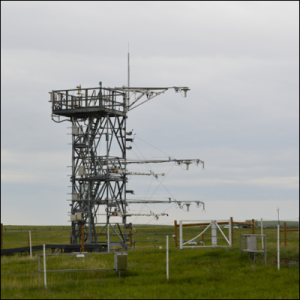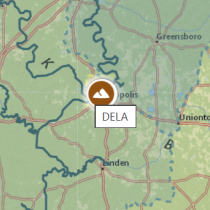The power of measuring vertical wind profiles using NEON towers
November 19, 2015
By Leslie Goldman & Cove Sturtevant
Did you know that wind speed can be determined by measuring the speed of sound? Since sound is “carried” by the wind, the speed of sound will be faster in the direction that the wind is blowing. These measurements can be collected using sonic anemometers. The sonic anemometer mounted at the top of NEON flux towers measures horizontal and vertical wind speed, and sonic anemometers mounted at lower levels of the towers measure horizontal wind speed. Measurements are collected in the same fashion across all NEON towers allowing for comparisons between sites, and preliminary wind speed data are currently available from many field sites.
Standardized monitoring of the flux scale at NEON field sites
Wind speed is just one of many standardized flux scale measurements that will take place at NEON’s terrestrial field sites across the U.S. over the next 30 years. Tower sensors monitor physical and chemical properties of the atmosphere, such as wind speed, humidity, carbon dioxide and reactive nitrogen. From these sensors we can measure net ecosystem exchange or the amount of gas that is exchanged between the atmosphere and the ecosystem.
The towers extend past the top of the vegetation canopy at each site to allow sensors mounted at the top and along the tower to capture the full profile of atmospheric conditions from above the vegetation canopy to the ground. Automated tower sensors collect data continuously to capture patterns and cycles across various time periods, ranging from seconds to years.
Determining the flux scale
The vertical wind profile provided by NEON towers makes estimation of surface properties that determine the flux scale simple and direct. The vertical wind profile (how average wind speed varies with height above the ground) follows a characteristic logarithmic relationship from which we can derive several important physical properties of the surface. These properties include the zero-plane displacement of the wind profile and the surface roughness which strongly influence the source area of the mass, energy, and momentum fluxes measured by the tower.
In comparison, most existing flux-measurement towers are equipped with only eddy covariance instrumentation at the tower top, which requires the use of general parameterizations, greater assumptions, or less-direct methods of estimating surface properties.
Once fully operational, NEON will provide additional field site data such as gas concentration measurements, soil measurements at varying depths and airborne collected LiDAR and hyperspectral data. Some of these data may be combined with the vertical wind profile data to allow for the estimation of surface-atmosphere exchange with multiple methods (eddy covariance and flux-gradient), which allows independent comparison analyses and verification of flux measurements. The remainder will help users of NEON data interpret the variability in the fluxes to understand how and why ecosystems change over time.
Data skills and accessing the data
To work with wind speed data, users require moderately-advanced data skills, with basic knowledge of algorithmic programming such as R.
In the long term, all terrestrial NEON sites will collect 1 & 30 minute averages of wind speed, providing data for a variety of users including micrometeorologists and biometeorologists, from graduate students to senior research scientists.
These data can be used to compare surface properties over time and spatially across NEON sites which are strategically placed within 20 ecoclimatic domains to ensure statistical representation of ecological, physical and biological variability.
To explore currently available wind speed data, go to the NEON Data Portal and browse by the Atmospheric Data theme. These data are available from April, 2015 - Present from 15 field sites.
Bonus! Click this link to download the function Cove coded in R to compute the surface properties relevant to the figure in this story.

